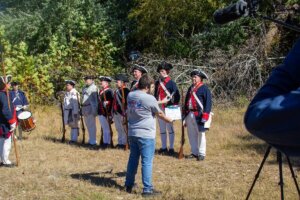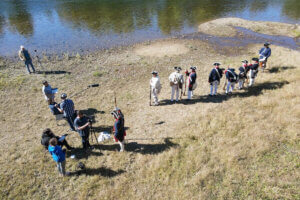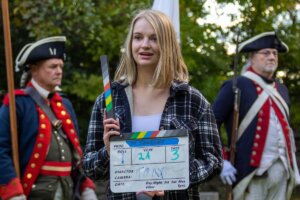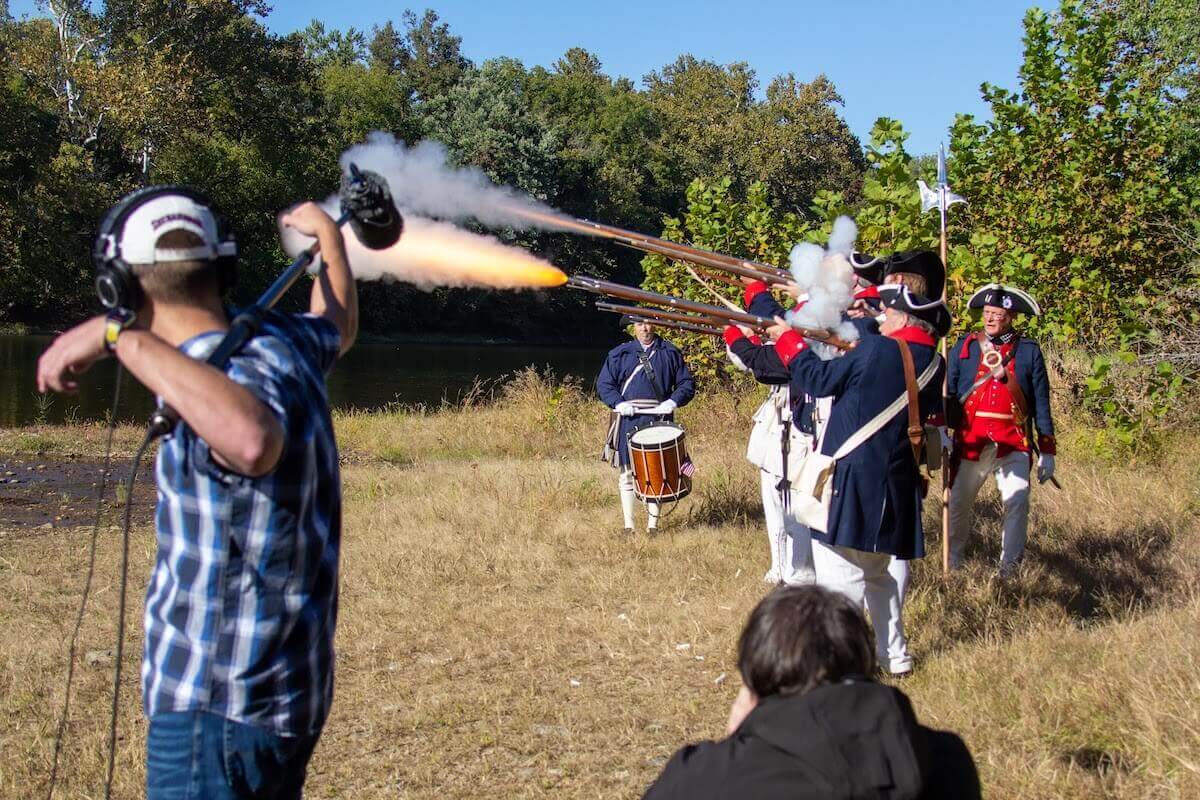A team of Shenandoah University students, faculty and staff produced a set of videos for the National Society of the Sons of the American Revolution (SAR) to help the organization train its members in activities such as musket drills and ceremonial duties for modern memorial services.
 The project was undertaken by SU’s Shenandoah Center for Immersive Learning (SCiL). Students Gabby Pieklo ’26, Kacey Graff ’24, Luke Yager ’25, Johnny Bernard ’23, Brynna Strader ’23, Ann Fink ’25 and Joey Miciotta ’24 all worked on the project, along with SCiL co-director and Associate Professor of Virtual Reality Design Nathan Prestopnik, Ph.D.; SCiL Immersive Media Specialist Lee Graff, M.Ed.; Assistant Professor of Film Production Anthony Brunner, M.F.A.; SCiL Immersive Technology Specialist Wes Brown; and SCiL Operations Manager Duasiane’ Benjamin, M.Ed.
The project was undertaken by SU’s Shenandoah Center for Immersive Learning (SCiL). Students Gabby Pieklo ’26, Kacey Graff ’24, Luke Yager ’25, Johnny Bernard ’23, Brynna Strader ’23, Ann Fink ’25 and Joey Miciotta ’24 all worked on the project, along with SCiL co-director and Associate Professor of Virtual Reality Design Nathan Prestopnik, Ph.D.; SCiL Immersive Media Specialist Lee Graff, M.Ed.; Assistant Professor of Film Production Anthony Brunner, M.F.A.; SCiL Immersive Technology Specialist Wes Brown; and SCiL Operations Manager Duasiane’ Benjamin, M.Ed.
Students filled various roles, performing tasks such as recording location sound and serving as camera and production assistants. Brunner served as the project’s director, Graff as director of 3D and drone videography, and Dr. Prestopnik as producer. Graff also served as editor, producing final versions of the videos with help from the students.
The project was a true cross-disciplinary collaboration that drew upon the skills and resources from various academic programs at Shenandoah.
Working for SAR was an educational and gratifying opportunity. As an audio student, being conversant in my field is one thing, but getting the chance during my studies to apply my skills with amazing folks is another. Capturing procedural footage and seeing it in person was an enthralling experience.”
Johnny Bernard ’23, Shenandoah Conservatory student majoring in collaborative audio arts

“This production was an amazing opportunity to bring together faculty, staff and students from film, VR and other majors across campus,” Prestopnik said. “Not only did our students learn a lot about the production process, but they also found themselves steeped in the history of the American Revolution for a full weekend on set.”
To capture the necessary footage for the training videos, Shenandoah hosted members of the SAR at the Shenandoah River Campus at Cool Spring Battlefield in Clarke County, Virginia, and at Hopewell Friends Meeting House in Clear Brook, Virginia, in Fall 2022.
 SU’s team recorded video of SAR members simulating ceremonial duties performed during memorial services, wreath layings, funerals and similar events, and musket drills demonstrating weapon safety and volley fire. The SAR performed live-fire volleys of Revolutionary War-era muskets during the recording, a process that Prestopnik said involved a lot of safety precautions and considerations, but was both educational and exciting for the students, faculty and staff involved.
SU’s team recorded video of SAR members simulating ceremonial duties performed during memorial services, wreath layings, funerals and similar events, and musket drills demonstrating weapon safety and volley fire. The SAR performed live-fire volleys of Revolutionary War-era muskets during the recording, a process that Prestopnik said involved a lot of safety precautions and considerations, but was both educational and exciting for the students, faculty and staff involved.
“This production was the first time these students had ever been on a professional video shoot,” Lee Graff said. “It was extremely valuable for them to be exposed to this process, including how to behave and function on set as a team. Even the little things, like how to hold a boom mic or what to say when using the clap board, are a huge benefit for the students as they move forward with their education and career goals.”
The finished product – a set of three videos – was delivered to the Sons of the American Revolution in November.
One of the reasons I love Shenandoah is because of opportunities like these. I got to experience what it’s like to be on a real film set. Even though I don’t see my career heading in that direction, it’s incredibly valuable to see a variety of things that I can then apply to my own pursuits.”
Brynna Strader ’23, virtual reality design student
Sons of the American Revolution Color Guard Commander and Historian General Brooks Lyles expressed his “sincere thanks and appreciation” to the students and faculty at Shenandoah for their “invaluable assistance to the 37,000 members of the National Society of the Sons of the American Revolution.” Lyles added that the color guard training and black powder safety videos are particularly beneficial to the 41 state-level SAR color guards located throughout the country.
 “As the National Color Guard Commander, my staff and I are challenged by the geographic dispersion of our many members and the challenge in setting standards and effectively training our members, new and old, in the proper ways of 18th century soldiering,” Lyles said. He added that the various commands and equipment, how the uniforms are worn, the proper sequences for conducting drills and, most importantly, the procedures for safely handling, firing and inspecting replica flintlock weapons can only be truly understood when you see them done.
“As the National Color Guard Commander, my staff and I are challenged by the geographic dispersion of our many members and the challenge in setting standards and effectively training our members, new and old, in the proper ways of 18th century soldiering,” Lyles said. He added that the various commands and equipment, how the uniforms are worn, the proper sequences for conducting drills and, most importantly, the procedures for safely handling, firing and inspecting replica flintlock weapons can only be truly understood when you see them done.
You can read Baron Von Steuben’s Blue Book and the various other manuals of the day, but there is no better way to learn the right way than to see it done and to be able to mimic the steps and procedures until you commit it to muscle memory. There is nothing better than seeing what ‘right’ looks like, and this is right, in every sense. Thanks to everyone involved in working with our National Safety Officer Brett Osborn and his team to make these three outstanding videos.”
Brooks Lyles, Sons of the American Revolution color guard commander and historian general




